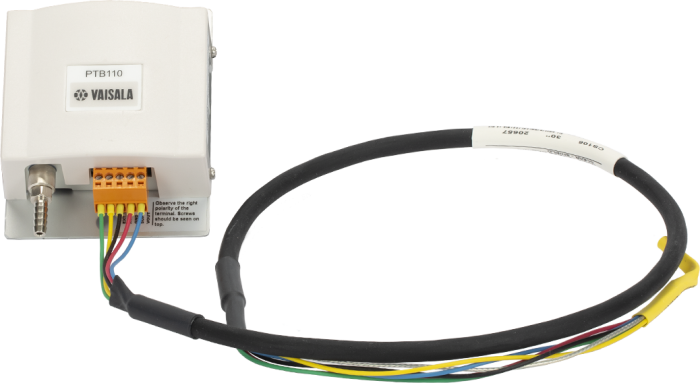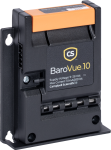
耐候性屋外収納ケース内に収納






概要
Vaisala 製の CS106 は、500 ~ 1100 hPa (mBar) の範囲の気圧を測定します。この範囲は、海面下 (鉱山など) から海抜 15,000 フィート以上までの範囲に相当します。環境アプリケーション用に設計された CS106 は、ほとんどの Campbell Scientific データ ロガーと互換性があります。CS106 には、76.2 cm (30 インチ) のケーブルが付属しています。
続きを読む利点と特徴
- Campbell Scientific の筐体に取り付けるよう最適化
- 一体型スイッチング回路により、測定サイクルの電力消費を制限
- 3 年間保証
イメージ



詳細
CS106 は 0 ~ 2.5 Vdc の線形信号を出力するため、気圧計を Campbell Scientific データロガーに直接接続できます。内部のスイッチング回路により、データロガーは測定中のみ CS106 に電力を供給できるため、消費電力が削減されます。
仕様
| -注意- | 1 hPa = 1 mBar |
| 圧力範囲 | 500 ~ 1100 hPa |
| 長期安定性 | ± 0.1 hPa / 年 |
| 整定時間 | 電源投入後、1秒で完全な精度に到達 |
| 応答時間 | 完全な精度に達するまでに500ミリ秒かかる |
| 出力電圧 | 0 ~ 2.5 Vdc |
| 供給電圧 | 10 ~ 30 Vdc |
| 標高 | 海抜下約609.6メートル(2,000フィート)(鉱山内)から海抜4,572メートル(15,000フィート)まで |
| 正確度 |
|
| 直線性 | ±0.25 hPa |
| ヒステリシス | ±0.03 hPa |
| 再現性 | ±0.03 hPa |
| 校正の不確かさ | ±0.15 hPa |
| 消費電流 |
|
| 温度範囲 | -40° ~ +60°C |
| 寸法 | 6.8 x 9.7 x 2.8 cm (2.7 x 3.8 x 1.1 in.) |
| ケーブル長 | 76.2 cm (30 in.) |
| 重さ | 90 g (3.2 oz) |
互換性
注意: 以下は代表的な互換性情報を示しています。互換性のある製品や互換性のない製品をすべて網羅したリストではありません。
Data Loggers
| 製品 | 互換性 | 注意 |
|---|---|---|
| CR1000 (リタイア) | ||
| CR300 (リタイア) | ||
| CR3000 (リタイア) | ||
| CR310 | ||
| CR350 | ||
| CR6 | ||
| CR800 (リタイア) | ||
| CR850 (リタイア) |
互換性に関する追加情報
データロガーに関する考慮事項
取り付け
CS106 は通常、ENC12/14 以上の屋外収納ケース内のデータロガーの隣に取り付けられます。とても小さい ENC100 は、CS106 を専用の屋外収納ケースに別々に収納するために使用できます。
ドキュメント
マニュアル
よくある質問
CS106に関するよくある質問の数: 12
すべて展開すべて折りたたむ
-
CS106 は直接の代替品ではありません。以前 CS105 を使用していたシステムで CS106 を使用するには、プログラムで乗数とオフセットを変更する必要があります。CS106 はウォームアップ時間が長いため、センサのオン/オフを繰り返す場合は、ウォームアップ時間を調整する必要がある場合があります。
-
CS106 のセンサ プラグは CS105 のものと同じです。ケーブルと接続がまだ正常に動作している場合は、ステーションの電源をオフにして、問題なくセンサを交換できるはずです。
-
ノイズの多い測定は、いくつかの要因によって発生する可能性があります。
- センサが十分に暖まらなかった。
- センサが電気的にノイズの多い環境に設置されているため、他のアナログ測定にノイズが混じる。
- センサまたはステーションの電源が汚れている。(クリーンな調整電圧がない。)
-
はい、ただし特定の条件が満たされた場合のみです:
- センサは結露しない環境に設置されています。
- 高湿度環境にアクセスする通気管は、水分がセンサのコンポーネントに届かないように、非常によく乾燥されています。センサに水分があると、センサが損傷し、修復不可能な状態になることがよくあります。
-
CS100 または CS106 のいずれかを ENC100 内に収めることができます。詳細については、ENC100 製品ページの仕様情報を参照してください。
-
ほとんどの場合、筐体や建物には、圧力が外圧と平衡を保つのに十分な小さな空間があります。したがって、センサを外部に排気する必要はありません。ただし、筐体内にあることで圧力が均等になる速度が遅くなることはありますが、速度の変化は通常顕著ではありません。
センサが完全に気密な環境にあり、この環境の外部の圧力を測定する必要がある場合は、センサを外部に排気する必要があります。ただし、外部に排気すると、筐体または関連する内部環境の定格が変わる可能性があります。
-
製造元は毎年の校正を推奨しています。ただし、公開されている規格や規制に準拠するには、より頻繁な校正が必要になる場合があります。
-
-
一般的に、これらのセンサは設置されている環境の圧力を測定するように設計されています。CS100 または CS106 は、筐体が雪から十分に密閉され、通気口が雪にアクセスできる状態であれば、積雪内の気圧を測定できます。ただし、これを実現するのは難しい場合があることに注意してください。
ケーススタディ
南アフリカ南西部では、2015年から2017年まで3年連続で乾燥した冬が続き、2018年初頭にはケープタウンで「デイゼロ」干ばつが発生しました。ケープタウンの水危機は、シャツを洗う回数を誰が一番少なくできるかを競うコンテストが行われるほどに悪化しました。レストランや企業でさえ、客や従業員に排水を減らすよう呼びかけました。この時点で、同市は水道を止めるまであと90日というところでした。 1年後、南アフリカのこの都市の干上がったダムは80%以上が満水になりました。水使用制限は緩和され、ケープタウンの市営水道が停止される「デイ・ゼロ」は到来しませんでした。この危機の回避に関する詳細は、この世界経済フォーラムの記事で確認できます。 乾燥した冬に必要となったケープタウン市は、霧の採取によってこの地域の主な水源を補う可能性を測るプロジェクトをテーブルマウンテンで立ち上げました。まだ初期段階ではありますが、このプログラムの考案者は、山に複数の霧捕集装置を建設することの実現可能性を判断したいと考えています。実現可能性調査と研究段階は、2022年12月までに完了する予定です。 このケース スタディの公開日現在、テーブル マウンテンには、基本的な気象パラメータと収集された霧を測定するための 2 つの Campbell Scientific 気象ステーションが設置されています。両方の気象ステーションには、霧から水を捕らえる、つまり「収穫」するために特別に設計された 1.5 m² (16.2 ft²) のスクリーンが装備されています。 ケープタウン市は、スクリーンに使用できるさまざまな素材のオプションをテストしています。1 つのスクリーンは 40%......続きを読む
国連開発計画(UNDP)の危機予防とレジリエンス構築コンポーネントの一環として、国際機関は、地域の気候に関する知識を向上させるために、2021年12月末までに4つの自動気象観測所(AWS)のネットワークの取得と運用開始に資金を提供しました。特定のニーズを満たすために、追加の完全な移動式ステーションも利用できます。 コモロ連合は南半球の夏季に季節性サイクロンに見舞われることに留意すべきです。2018~2019年のシーズン中、サイクロン「ケネス」は、強烈な熱帯低気圧(風速166 km/h以上)の段階で、群島、特にラ・グランド・コモロ島の海岸に非常に接近し、人的被害とインフラ被害の両方を引き起こしました。 このため、最初から領土全体にわたるアプローチが展開されました。コモロ連合は 4 つの島 (アンジュアン島、グランドコモロ島、マヨット島、モヘリ島) で構成されています。グランドコモロ島には 2 つのステーション (モロニ島とオイチリ島)、アンジュアン島には 1 つのステーション (ドモニ島)、モヘリ島には 1 つのステーション (ミリンゴニ島)......続きを読む
現在、アンデスの熱帯氷河は急いで後退しています。 これらの氷河は、ペルー南部の乾燥した冬と干ばつの間、恒久的な水源であると考えられています。手前にいるため、この状況は注目を集めています。 コロプナはペルー最大かつ最も高い火山で、リマの南1,000 km (620 マイル) のアレキパにあります。 最高標高は 6,400 m (21,000 フィート) で、ペルーで約 3 番目に高い地点であり、年間降水量が......続きを読む
過去数年間、電力業界では、ユタ州の天然資源を電力生産にもっと活用しようと奮闘してきました。提案された施設を建設するために必要な許可を得るために、電力会社は、現場の状況を表す最新の気象データと大気質データを使用して、提案された発電所の敷地からの排出物をモデル化する必要があります。Metalotical Solutions, Inc. (MSI) は、ユタ州の提案された発電所または既存の発電所の敷地の基準条件を特徴付ける気象および大気質監視システムを設置して運用しました。最低 1 年間の有効なデータが必要であり、高いデータ回復率を保証するために厳格な品質管理措置が実施されています。データは、Campbell Scientific CR23X データロガーを使用して 1 秒値から計算された 15 分間の平均値として収集および保存されます。信頼性の高い固定電話または携帯電話接続により、設置されたデータロガーを頻繁に照会してデータを取得し、データの有効性を確認することができます。Campbell Scientific......続きを読む
アルゼンチンのような広大な国では、さまざまな農業地域の生育状況を監視するのは大変な作業です。国土の大部分は乾燥しており、水の使用と分配が重要になります。この取り組みを支援するために、監視制御およびデータ収集 (SCADA) を使用して、国の主な果樹栽培地域に水を供給する 2 つの大きなダムの水量を監視および制御しています。 この計測機器は、アルゼンチンのほとんどの製品の輸送に使用される川の水位を適切に維持しながら灌漑要件のバランスをとるのに役立ちます。 この水文気象システムは、リオス・リマイ、ネグロ、ネウケンのクエンカス州間管区管理局 (AIC) 向けに設計されました。AIC は、ネウケン川、リマイ川、ネグロ川から国内の灌漑地域への給水管理を担当しています。ブエノスアイレスとマルデプラタに拠点を置くアルゼンチンの企業 Electronica Naval が、AIC に 80 のステーションを提供する契約を獲得しました。このシステムは 100,000......続きを読む
以下に記載
Privacy Policy Update
We've updated our privacy policy. 詳細はこちら
Cookie Consent
Update your cookie preferences. クッキーの設定を更新する






